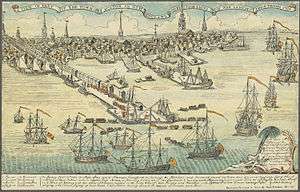Journal of Occurrences
The "Journal of Occurrences", also known as "Journal of the Times" and "Journal of Transactions in Boston", was a series of newspaper articles published from 1768 to 1769 in the New York Journal, chronicling the occupation of Boston by the British Army. Authorship of the articles was anonymous, but is usually attributed to Samuel Adams, then the clerk of the Massachusetts House of Representatives. William Cooper, Boston's town clerk, has also been named as a possible author. The articles may have been written by a group of men working in collaboration.

The occupation of Boston arose from colonial resistance to the Townshend Acts, passed by the British Parliament in 1767. In response to acts, the Massachusetts House of Representatives issued the Massachusetts Circular Letter in February 1768. Also written primarily by Samuel Adams, the circular letter argued that the Townshend Acts were a violation of the British Constitution because they taxed British subjects without their having a say in the matter. Lord Hillsborough, British Secretary of State for the colonies, ordered the Massachusetts House to revoke the circular letter. But the legislature refused. In addition to this act of colonial defiance, Hillsborough also heard reports from the Board of Customs—who were in charge of enforcing trade regulations—that Boston was in a state of anarchy. The British ministry dispatched four regiments of the British Army to restore order. These troops began arriving in October, 1768.
The first installment of the "Journal" was published on October 13, 1768, and continued once a week for more than a year. In an innovative approach for an era without professional newspaper reporters, the "Journal" presented a narrative of shocking events in Boston to the outside world. Although the authors claimed that what they wrote was "strictly fact", the events depicted in the articles were apparently exaggerated for polemical effect. Drawing upon the traditional Anglo-American distrust of standing armies garrisoned among civilians, the "Journal" presented a Boston besieged by unruly British soldiers, who assaulted men and raped women with regularity and impunity. The customs commissioners were also portrayed negatively.
Although British officials in Boston insisted that the events depicted in the "Journal" were mostly fictitious, the articles were widely reprinted, and they helped build the sentiment that eventually produced the American Revolution.
References
- Alexander, John K. Samuel Adams: America's Revolutionary Politician. Lanham, Maryland: Rowman & Littlefield, 2002. ISBN 0-7425-2115-X.
- Dickerson, Oliver M., ed. Boston under Military Rule (1768–1769): As Revealed in a Journal of the Times. Boston: Chapman & Grimes, 1936.
- Fowler, William M., Jr. Samuel Adams: Radical Puritan. New York: Longman, 1997.
- Streitmatter, Rodger. Mightier Than the Sword: How the News Media Have Shaped American History. Westview Press, 2007.